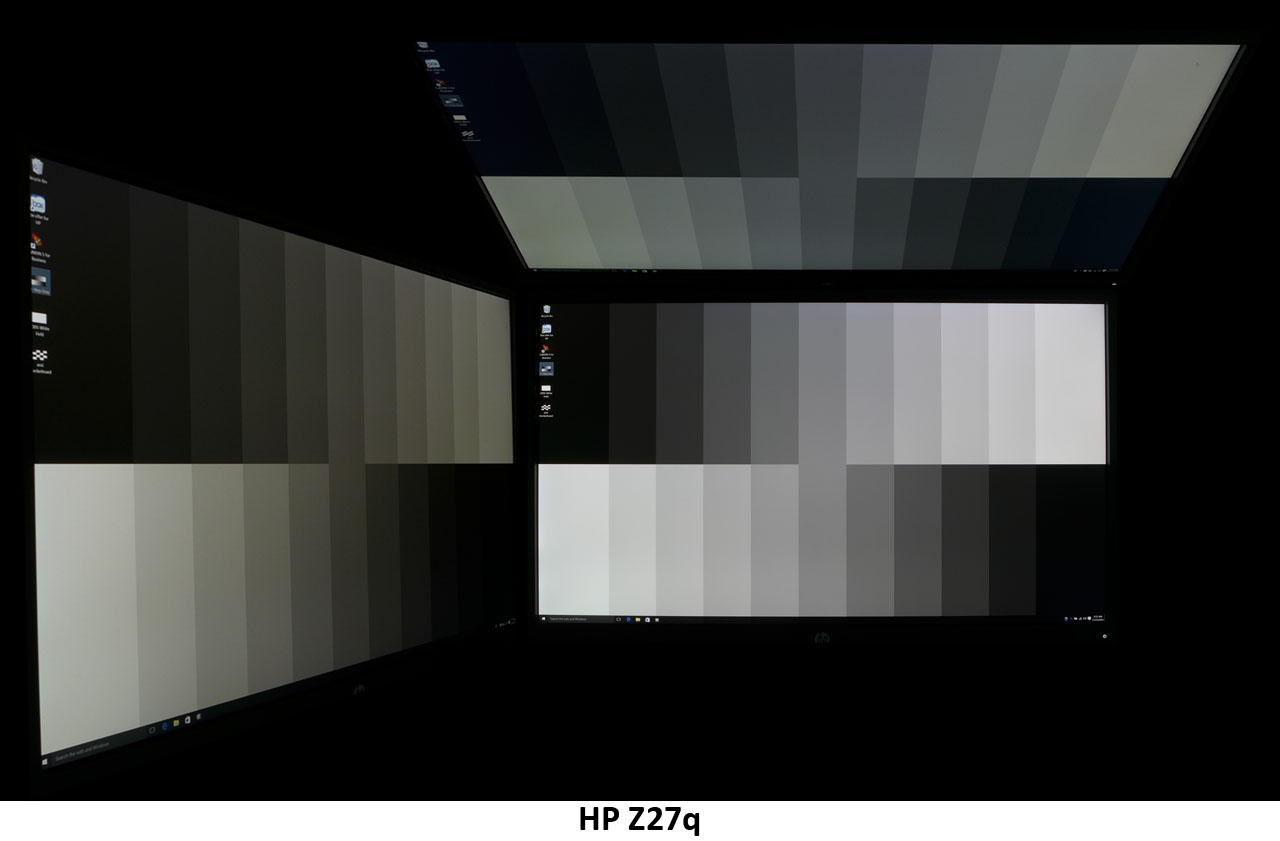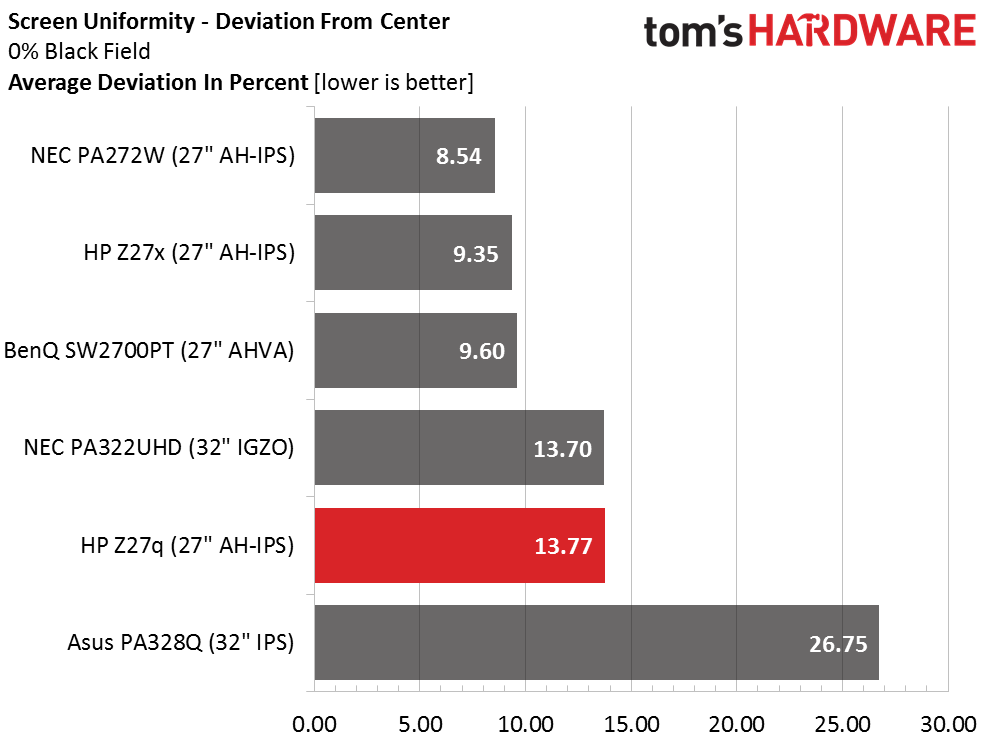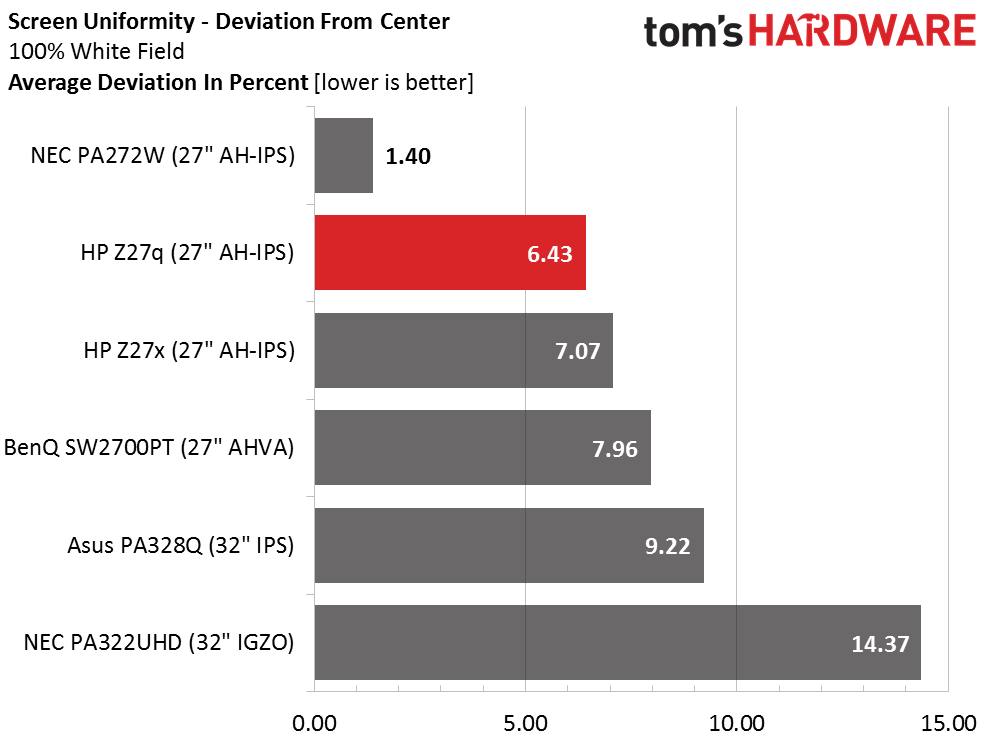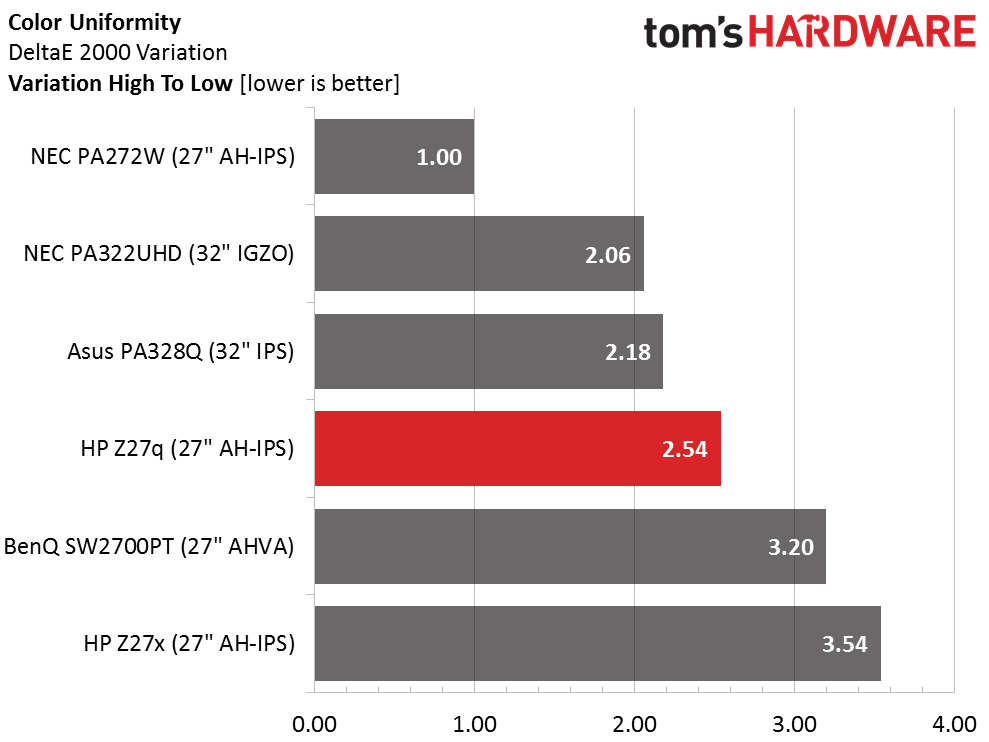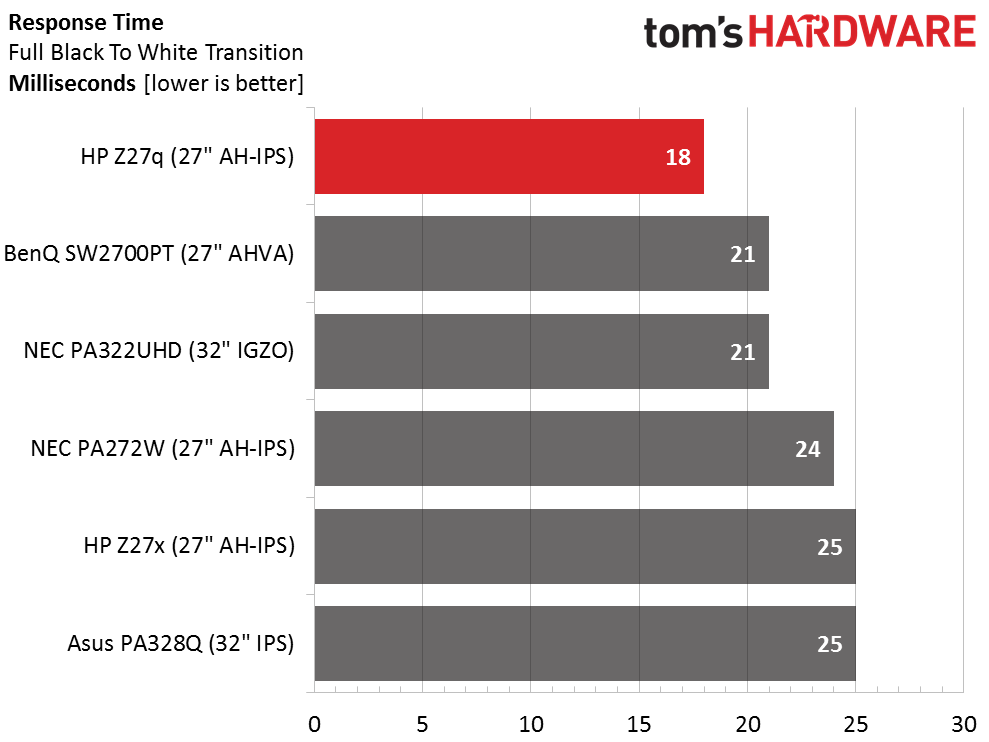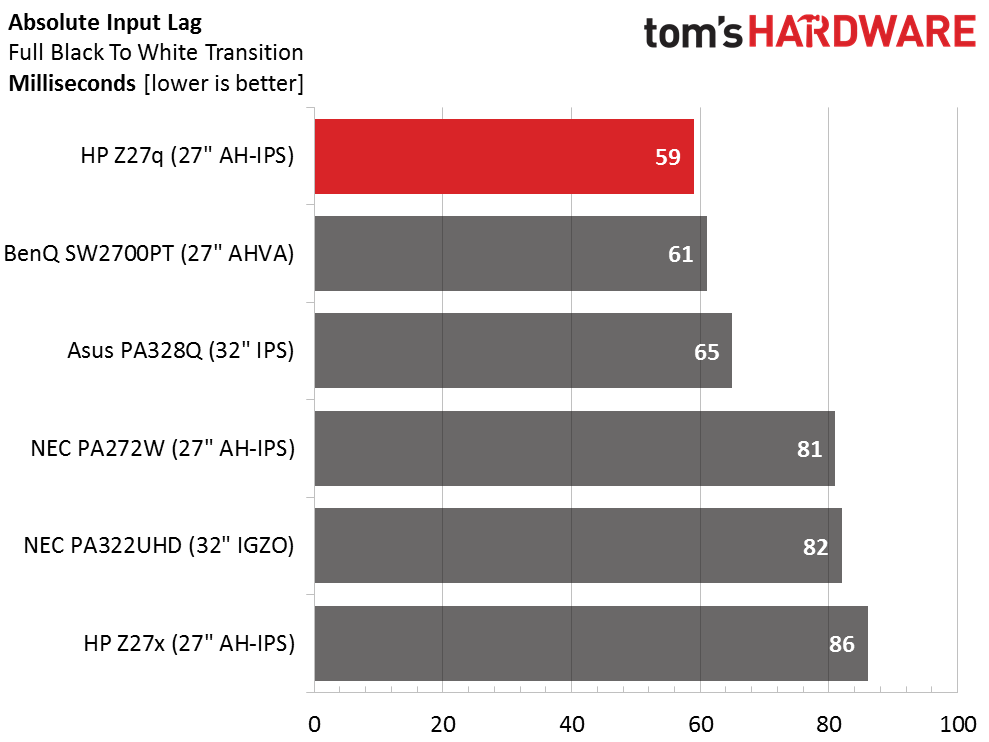HP Z27q 27-inch 5K Professional Monitor Review
Just as we're getting acquainted with Ultra HD, HP has upped the ante with a 5K monitor. At 5120x2880 the Z27q puts a whole lotta pixels on the screen, 14,745,600 in fact. Today we check it out in our lab.
Why you can trust Tom's Hardware
Viewing Angles, Uniformity, Response And Lag
To learn how we measure screen uniformity, please click here.
The Z27q's off-axis performance is typical of modern IPS panels. Viewing the image at 45 degrees to the side results in a moderate light falloff and a slight color shift to green and red. The same is true when viewed from the top down. Detail is well-preserved even in the darkest steps so image integrity should be acceptable to viewers not sitting in the center seat.
Screen Uniformity: Luminance
In the ANSI contrast test we noted two hotspots in the upper-left and lower-right corners. Those same areas affect the Z27q's black field uniformity. 13.77 percent isn't a bad result but other screens score better. In practice it doesn't qualify as true light bleed but in a dark environment you can just make out the extra brightness in those two corners.
Here's the white field measurement.
The white field result is considerably better with no visible issues whatsoever. In fact, once the field patterns exceed 10 percent those hotspots we mentioned become completely invisible. The Z27q doesn't include any uniformity compensation but we'd say given the performance of our sample, it's not needed.
Screen Uniformity: Color
Color uniformity is equally competent and exhibits no visible tinting anywhere on the screen. Smooth tones are all you'll see at every brightness level including the 80 percent mark we test at.
Pixel Response And Input Lag
Please click here to read up on our pixel response and input lag testing procedures.
Get Tom's Hardware's best news and in-depth reviews, straight to your inbox.
Panel response is quicker than we'd expect given the high pixel count. We don't expect to see much gaming on this monitor at its native resolution, but full-motion video exhibits far less motion blur than many other displays.
Here are the lag results.
Input lag is also quite impressive. We credit some of that to the AMD FirePro graphics card but this is a pretty snappy panel considering how much processing is going on. It's one of the faster IPS screens we've tested at any resolution.
Current page: Viewing Angles, Uniformity, Response And Lag
Prev Page Color Gamut And Performance Next Page Conclusion
Christian Eberle is a Contributing Editor for Tom's Hardware US. He's a veteran reviewer of A/V equipment, specializing in monitors. Christian began his obsession with tech when he built his first PC in 1991, a 286 running DOS 3.0 at a blazing 12MHz. In 2006, he undertook training from the Imaging Science Foundation in video calibration and testing and thus started a passion for precise imaging that persists to this day. He is also a professional musician with a degree from the New England Conservatory as a classical bassoonist which he used to good effect as a performer with the West Point Army Band from 1987 to 2013. He enjoys watching movies and listening to high-end audio in his custom-built home theater and can be seen riding trails near his home on a race-ready ICE VTX recumbent trike. Christian enjoys the endless summer in Florida where he lives with his wife and Chihuahua and plays with orchestras around the state.
-
Xajel So, how long till we will see a 21:9 version of these... the 21:9 version will be good, as it will you give you the 21:9 ratio and still be able to view a full 4K resolution in the same time, as 21:9 version will have 2160 vertical resolution with 5K width... final res is 5120x2160Reply -
Tanquen Rent is too damn high!Reply
27" is too damn small! (So is anything under 34" for 4 and 5k screens.) -
thor220 ReplyNo measurement of power consumption? Did you lose your Kill-A-Watt?
This is a professional monitor and one of the few 5k screens on the market. Power consumption does not matter. -
10tacle Ping me when this resolution is available in 32"...and there are GPUs powerful enough to run games at that resolution since even SLI 980Tis get taken to their knees in 4K in games like Witcher 3.Reply -
Bghead8che Too bad regarding the Adobe RGB test. Otherwise a pretty decent monitor, especially for the price. You wonder if the Adobe RGB issue is specific to the exact monitor they tested or it affects all HP Z27q models?Reply -
Larry Litmanen ReplyPing me when this resolution is available in 32"...and there are GPUs powerful enough to run games at that resolution since even SLI 980Tis get taken to their knees in 4K in games like Witcher 3.
I have a 34 inch Dell Monitor, 21:9,, rather than wait until the GPUs will become powerful enough i simply temporarily switched to playing AAA games on the XBox One. So i have the monitor for general PC activity and play Xbox on it as well.
Realistically it is simply too much to drop all that money on the monitor and a GPU, of the two i think GPU can wait.
-
Karsten75 You say "... it will send a true 10-bit signal to the display."Reply
That is one of my perennial questions. How to verify that when looking at a monitor's specifications. Can you provide any guidance in that area? I lnow that 10-bit (or 8-bit) is important for the entire path of image production, but I do not always know how to ensure that. -
none12345 The more 200ppi screens the merrier. As far as processing power for games...ya we arent there yet, but we should have gpus later this year that will be fine on that res. I wouldnt touch this screen tho because its only 60hz. Not touching 4k till there are a bunch of 120hz monitors out. All thought id really like an OLED screen next, id really like to see 10bit per channel 120hz OLED become average for monitors.Reply
